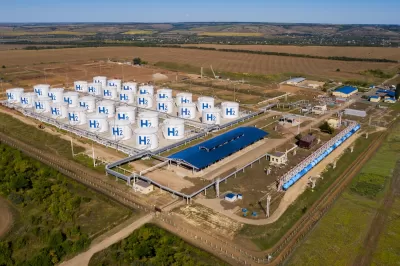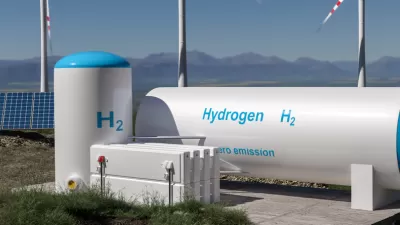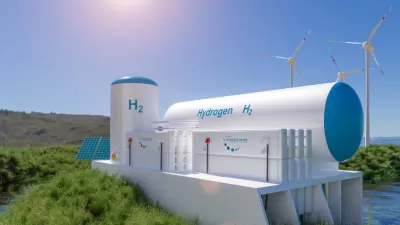The U.S. Department of Energy announced on July 17 that the first grant to build the nation's seven proposed 'hydrogen hubs' would go to California. The ultimate goal is to decarbonize transportation fuels used in port operations.

The Energy Department's Office of Clean Energy Demonstrations announced on July 17 the award of $30 million to the California Hydrogen Hub, “a network of clean hydrogen production sites that incorporate multiple facilities at California ports.”
The expansion of hydrogen fuel cell vehicles in heavy-duty transportation aims to not only drive improvements in air quality along high pollution interstate transportation corridors but also to facilitate greater connectivity and expansion of a clean West Coast freight network that links to the Pacific Northwest Hydrogen Hub.
“California’s hub will produce hydrogen exclusively from renewable energy [known as green hydrogen] and biomass, while other hubs will experiment with other sources,” reported Hayley Smith for the Los Angeles Times on Oct. 13, 2023, when the U.S. Department of Energy announced “$7 billion to launch seven Regional Clean Hydrogen Hubs (H2Hubs) across the nation” made possible by the passage of the Infrastructure Investment and Jobs Act (IIJA) on Nov. 5, 2021.
Pacific Northwest H2 Hub
A week after the Office of Clean Energy Demonstrations awarded the initial funds to kickstart the California hub, OCED awarded $27.5 million to the Pacific Northwest Hydrogen Hub.
OCED is working with PNWH2 to build a clean hydrogen ecosystem across Washington, Oregon, and Montana that leverages the region’s abundant renewable resources to produce all of its hydrogen exclusively via electrolysis using clean, carbon free energy, facilitating greater connectivity and expansion of a clean West Coast freight network that links to the California Hydrogen Hub.
Clean hydrogen
The Rhodium Group shed light on the distinction between clean and conventional hydrogen in a nine-page report published Sept. 9, 2021, a month after the IIJA passed the Senate and nearly two months prior to passage in the House.
As Congress considers policy support for hydrogen technologies, it is essential to understand the distinction between how we use hydrogen today and the role of hydrogen in a decarbonized US economy. Hydrogen currently plays a crucial function in our economy, primarily as an industrial feedstock. Nearly all of today’s supply is from steam methane reformation, an emissions-intensive form of hydrogen production made from natural gas.
Russ Mitchell, who covers energy technology, including the state’s ambitious transition to electric vehicles, for the Los Angeles Times, reported on July 17 that “some environmentalists are wary of hydrogen, claiming it’s not as clean as its proponents make it out to be.”
That issue is sure to be debated as [the Alliance for Renewable Clean Hydrogen Energy Systems ] ARCHES moves forward. Depending on how the hydrogen is made, it could provide cleaner energy alternatives for hard-to-decarbonize sectors, such as steelmaking and cement production.
Additional reading:

Planetizen Federal Action Tracker
A weekly monitor of how Trump’s orders and actions are impacting planners and planning in America.

Congressman Proposes Bill to Rename DC Metro “Trump Train”
The Make Autorail Great Again Act would withhold federal funding to the system until the Washington Metropolitan Area Transit Authority (WMATA), rebrands as the Washington Metropolitan Authority for Greater Access (WMAGA).

The Simple Legislative Tool Transforming Vacant Downtowns
In California, Michigan and Georgia, an easy win is bringing dollars — and delight — back to city centers.

The States Losing Rural Delivery Rooms at an Alarming Pace
In some states, as few as 9% of rural hospitals still deliver babies. As a result, rising pre-term births, no adequate pre-term care and harrowing close calls are a growing reality.

The Small South Asian Republic Going all in on EVs
Thanks to one simple policy change less than five years ago, 65% of new cars in this Himalayan country are now electric.

DC Backpedals on Bike Lane Protection, Swaps Barriers for Paint
Citing aesthetic concerns, the city is removing the concrete barriers and flexposts that once separated Arizona Avenue cyclists from motor vehicles.
Urban Design for Planners 1: Software Tools
This six-course series explores essential urban design concepts using open source software and equips planners with the tools they need to participate fully in the urban design process.
Planning for Universal Design
Learn the tools for implementing Universal Design in planning regulations.
Smith Gee Studio
City of Charlotte
City of Camden Redevelopment Agency
City of Astoria
Transportation Research & Education Center (TREC) at Portland State University
US High Speed Rail Association
City of Camden Redevelopment Agency
Municipality of Princeton (NJ)





























